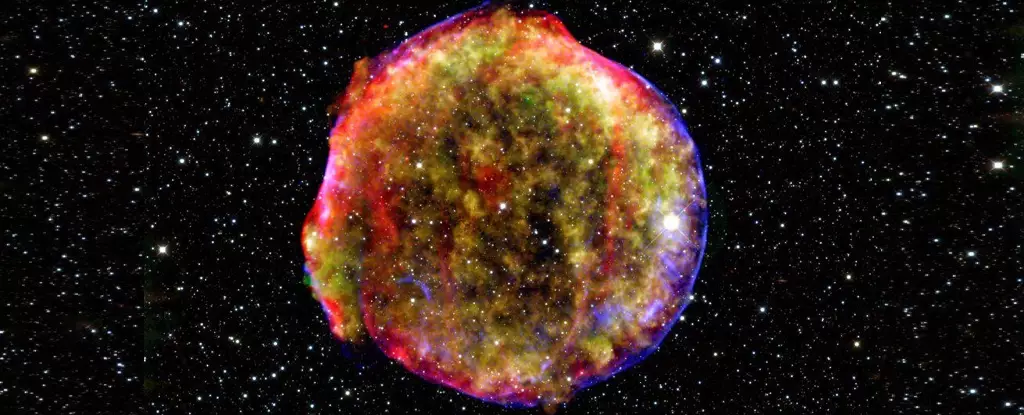In the vast expanse of our galaxy, a tantalizing mystery unfolds. Scientists believe there are engines out there—wondrous cosmic structures capable of catapulting atomic particles to velocities approaching that of light. At the forefront of this exploration lie the explosive remnants of supernovae, which have long been suspected as potential sources of these exceptionally energetic cosmic rays. Yet as researchers peer deeper into the mechanics of the universe, doubt begins to cast a shadow over this hypothesis. Recent simulations imply there could still be a chance to salvage the idea of supernovae as the universe’s preeminent particle accelerators, especially in their fleeting moment of collapse.
For over a century, physicists have been on a relentless hunt, combing the night sky for hints of the phenomena that unleash showers of atomic nuclei and scattered electrons upon Earth. Yet tracing their origins is a Herculean task; it’s akin to retrieving a bottle from the sea and speculating about its journey across tempestuous tides. The charged nature of cosmic rays makes them vulnerable to the chaotic magnetic fields they traverse, complicating the search for their birthplace. Investigations into one specific supernova, Tycho’s star—a spectacular event recorded in 1572—have underscored this pressing challenge.
Timeless Explosions and Their Implications
Tycho’s star exemplifies the drama of stellar demise. Its vibrant explosion was a white dwarf’s final act, a cataclysm fueled by thermonuclear processes. In the aftermath, the intense heat and radiation generated a confluence of magnetic fields, raising hopes that these dynamics could produce cosmic rays. However, a recent study published identified that the capacity of Tycho’s supernova to generate cosmic rays was “significantly smaller” than predicted by prevailing models, igniting skepticism regarding the potency of collapsing stars as particle accelerators.
The looming question is: What does this mean for stellar explosions as sources of high-energy cosmic rays? Although this research did not extinguish the possibility of supernovae as viable particle accelerators, it complicated the narrative and cast a shadow of uncertainty over how effectively they fulfill this role.
The Real Monsters Among Us
Beyond Tycho, Earth occasionally encounters true cosmic behemoths—particles of staggering energy, up to a thousand times stronger than anything achievable by human technology. To physicists, these legendary particles are manifestations of hypothetical cosmic engines they have dubbed PeVatrons. The pursuit of identifying these PeVatrons leads us back to the remnants of dying stars, yet the challenges abound. According to astrophysicists Robert Brose, Iurii Sushch, and Jonathan Mackey, the possibility remains that these stars could indeed serve as the elusive PeVatrons theorized.
However, for a collapsing star to become such an extraordinary accelerator, certain conditions must exist. A dense shell of ejected material needs to form around the star, providing a robust environment for the subsequent supernova explosion. It is within this tumultuous setting that the necessary magnetic turbulence can emerge, potentially accelerating nuclei and electrons to unprecedented levels. Timing remains crucial; only within the first couple of decades post-explosion will environmental conditions be dense enough to meet the stringent criteria for the production of PeV-level cosmic rays.
A Missed Opportunity or a Future Delight?
If celestial events transcend time and possibility, one cannot help but speculate: what would happen if Tycho’s star had delayed its bombing run by just a few centuries? Would we have witnessed an unprecedented shower of cosmic rays that could have reshaped our understanding of high-energy astrophysics? As we advance in our cosmic explorations, the end of another nearby star may unlock these secrets. The entwined dance of timing and intensity remains crucial, propelling us on this exhilarating journey through the universe’s enigmas.
What stands out is the urgency with which we must pursue answers, the compelling argument that the universe has more to reveal. Yet balancing skepticism with hope is a dance we must learn, as astronomers continue their arduous journey through the tangled web of space and time, beckoning the mysteries of the universe to unfold before us. Are we on the brink of a discovery that could revolutionize our understanding of cosmic energies, or will we endlessly circle back to questions long left unanswered? Only time, and perhaps the next supernova, will tell.

Leave a Reply